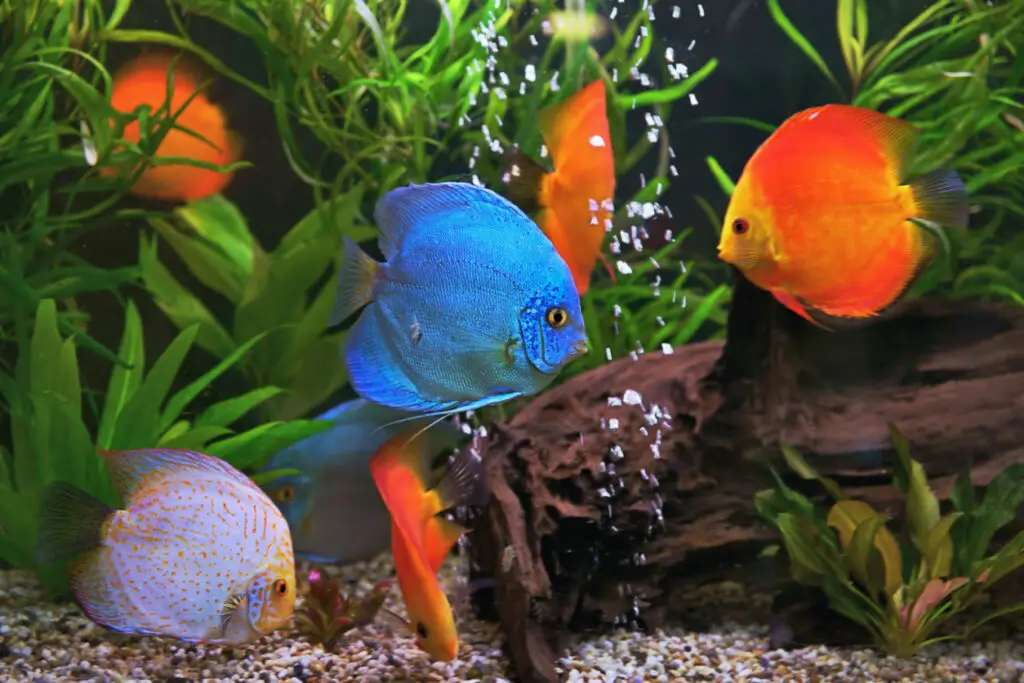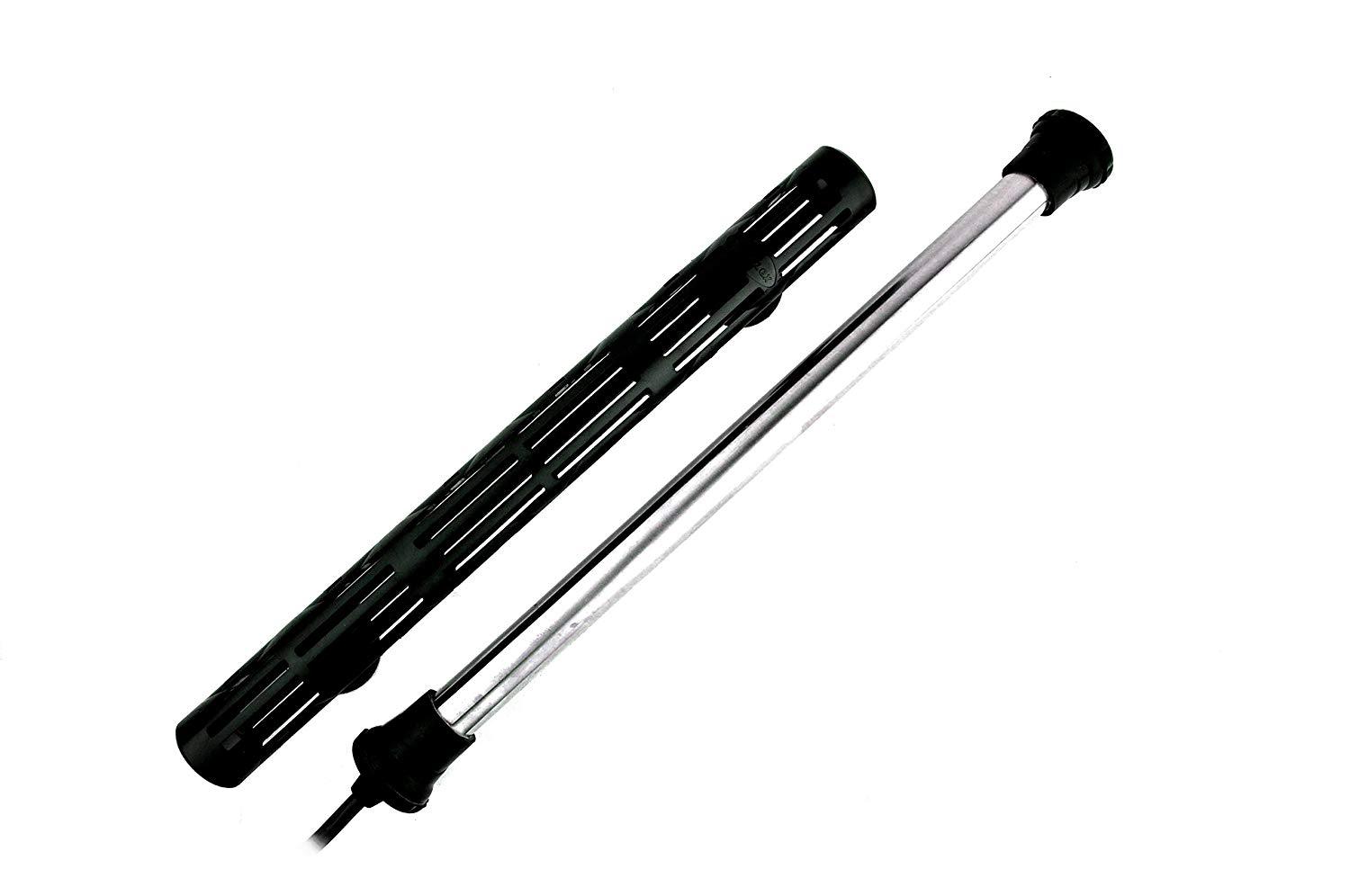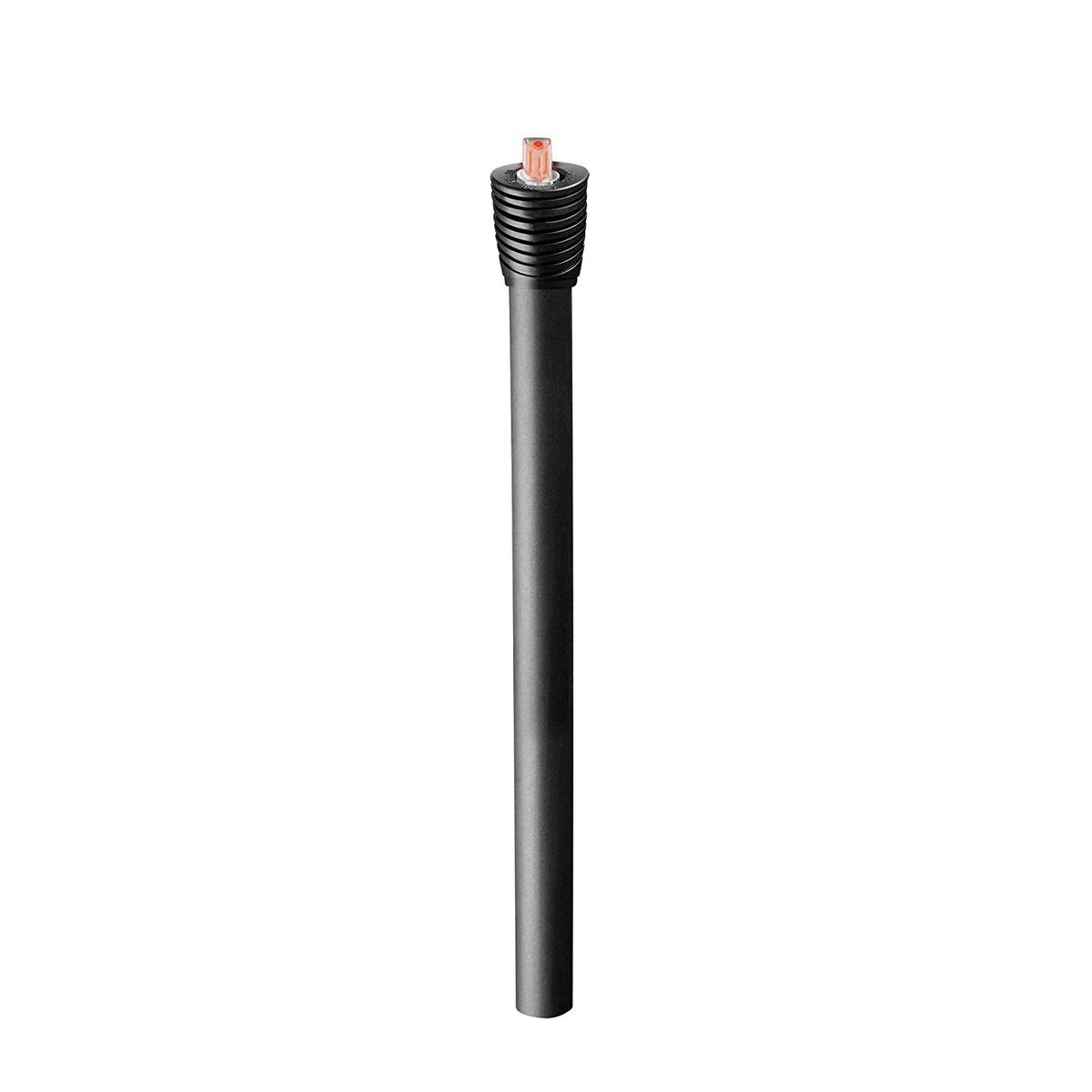Unless your home stays at the exact temperature that’s best for your fish, you’ll want your aquarium water to stay in the optimal range for your fish’s native habitat. You need an aquarium heater.
Fish are ectothermic, which means they rely on their environment to provide the heat their bodies need.
While there are severe health effects from water that is too warm, of course, there are also negative health effects from water that is too cool.
Cold water can cause stress and illness for fish and reduce their lifespan.
Even with an endothermic animal, I experience this every time I forget to turn on the thermostat during a cold snap!
Before I know it, I’m curled up in bed without regard to my to-do list. Over time, my body gets tired and I get sick. With fish, it’s kind of the same thing.
Author Note: The best aquarium heater will keep your fish at the right temperature, reducing their chance of developing illness or parasitic infections.
Even better, some fish are at their brightest and most beautiful at their optimal temperature.
Let’s find out what kind of fish tank heaters serve each individual tank the best.
Best Aquarium Heater Quick-Find Table
| Image | Product | |||
|---|---|---|---|---|
|
EDITOR’S CHOICE
|
EDITOR’S CHOICE
|
|
|
VIEW LATEST PRICE |
|
BEST WITH INTERNAL THERMOSTAT
|
BEST WITH INTERNAL THERMOSTAT
|
|
|
VIEW LATEST PRICE |
|
BEST DIGITAL HEATER
|
BEST DIGITAL HEATER
|
|
|
VIEW LATEST PRICE |
|
BEST IN-LINE HEATER
|
BEST IN-LINE HEATER
|
|
|
VIEW LATEST PRICE |
|
BEST ADJUSTABLE HEATER
|
BEST ADJUSTABLE HEATER
|
|
|
VIEW LATEST PRICE |
Do You Need an Aquarium Heater?
If you’re looking at buying an aquarium heater, it’s important to determine if your fish needs one. Then find the right one.
Certain fish, like minnows and goldfish, are content with living in water that is just room temperature.
Certain crustaceans like cherry, crystal, and freshwater shrimp do well in room temperature water.
Make sure you take the time to research to see what temperature your water dwelling pets need.
As for most of the other fish typically kept in aquariums, they originate from tropical regions that have water temps well above room temperature.
Top Tip: Depending on the fish you have, they could need water that is in the range of 75°F (24°C) to 82°F (28°C). If these fish get put into colder water, they will go into shock and eventually die.
Types of Heaters
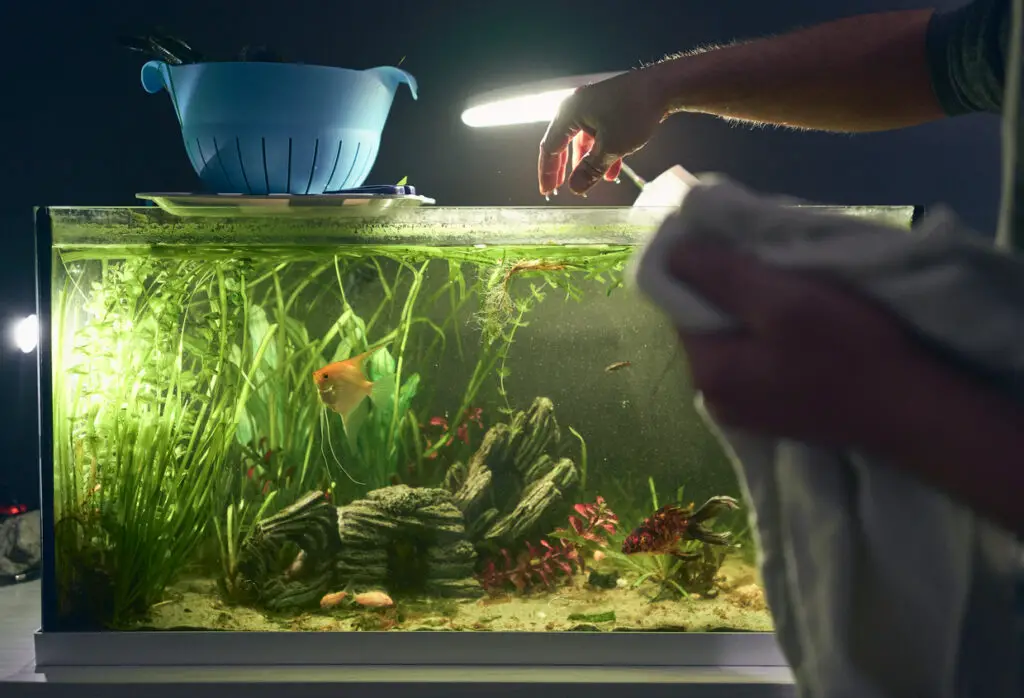
Hanging and Submersible aquarium Heater types
These are the most common types of heaters you’ll find in any store.
They look similar, so you’ll need to fully examine the description. A hanging heater cannot be fully submersed and will likely fail if it is submersed.
A submersible heater can be fully submerged – diagonally, horizontally, vertically.
They can fit right into your fish tank’s water flow to efficiently heat, and for something that will be placed into water, it can handle it.
These filters require attention to water changes as they can be damaged by being run dry or changes without allowing them to acclimate first.
Fully submersible heaters should come with suction cups to attach the heater to the aquarium wall.
Author Note: Know that any time you introduce something to your tank, your fish may get curious and get into it.
A heater directly inside your tank may invite a curious fish to investigate. Less careful fish may burn themselves on it.
If you have detective fish that want to get into your heaters, you can consider a different type of heater, such as a sump heater, or a style with a caging to keep your fish from touching the heater directly.
In this article, we’ll cover fully submersible aquarium heaters.
They may not be the right pick for everyone, but they are the perfect choice for most situations. Not only are they practical, but they are reliable, and you can depend on them running accurately for much longer than other varieties of heaters.
Sump aquarium heater
Sump heaters are simply heaters kept in the sump.
It’s a valid heating option if it keeps your water where you want it but do exercise caution if your sump is acrylic.
Acrylic tanks and titanium heaters are especially a cause for concern as the titanium can melt them.
In-line & In-Filter aquarium Heaters
Another common option, an in-line heater connects to the line from a canister filter into your tank, while an in-filter heater will be found inside a canister filter.
Both heaters are serving the same purpose of heating water while it runs through the filter and returning water at the optimal temperature.
Substrate aquarium Heater
A substrate heater is usually a cord with a thermostat that lines the substrate in your fish tank.
These are absolutely the best for plants.
They aren’t designed as much with fish in mind as live plants, with their roots in soil which may not heat as well as the water above it. They encourage plant growth and absorption of essential nutrients.
These heaters are not the best choice if you are looking to heat your fish, as they aren’t as exposed to water current to move the heat they produce, and the sensor doesn’t monitor the water.
Reviews of the Best Aquarium Heaters
After a ton of research and testing, here are our top 5 favorite aquarium heaters that get the job done at a reasonable price point.
We also cover a couple popular options that we feel aren’t high quality enough to make the cut, so be wary of buying things just because they have a lot of Amazon reviews…some of the top companies of the past have seen manufacturing standards slip!
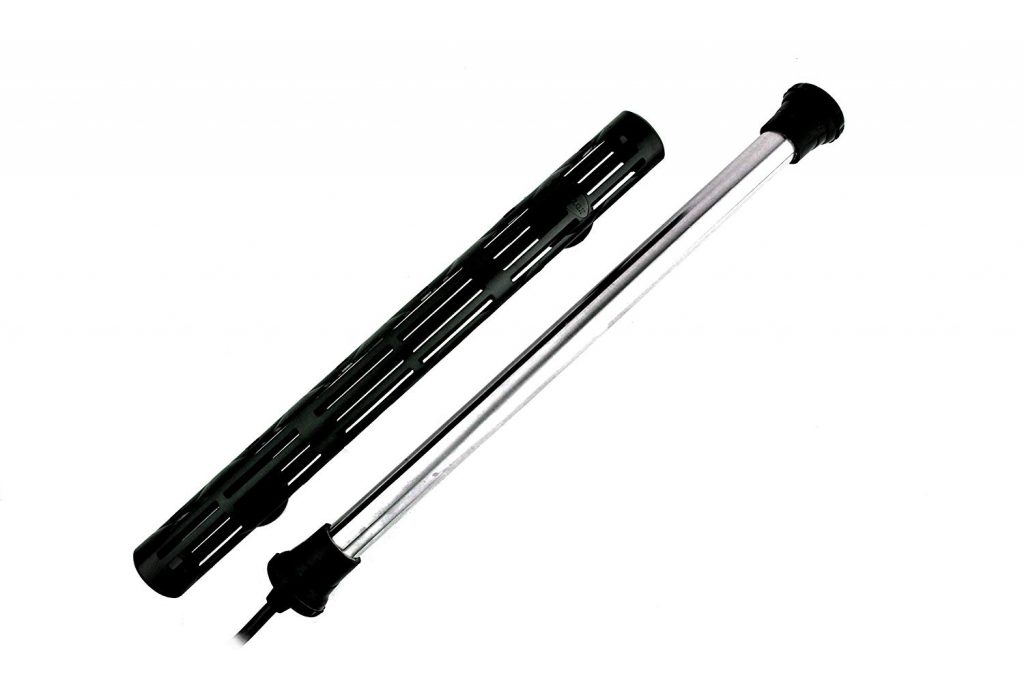
The Finnex Deluxe Titanium Heater is our top pick. It can handle up to 265 gallons with a single heater while working perfectly well for as little as 40 gallons!
This is a fantastic choice if you have a larger tank, want a little more heating power, or even just a more durable and reliable option.
If you’ve needed to throw out an aquarium heater before due to a thermostat issue – or worse, seen the consequences of a bad thermostat, you will be happy to know you can use your own thermostat to manage temperature.
This durable heater doesn’t limit itself to saltwater and will be at home in a freshwater tank as well.
What We Liked About This Product
- Heats up to 265 gallons
- Corrosion resistant; great for saltwater tanks
- Low cost
- Separate thermostat
- Heater cage
- Keeps up with high temperature species
- Reliable
Why It Might Not Work for You
- No included thermostat; must buy a separate controller
- Not good for small tanks
- Shouldn’t be used with acrylic
Our verdict: 5/5 stars. Buy it.
If you’ve got a 40-265-gallon glass tank and you’re willing to buy a controller, this is a fantastic choice.
Even with the cost of a controller, it’s hard to find something this well built in this price range.
As far as adjustability goes, it’s hard to get a more adjustable fish tank heater than one with an external controller that could even be set up to include a fan to run when it gets too warm.
>> Tap Here to Read More Reviews and See Today’s Price on Amazon.com <<
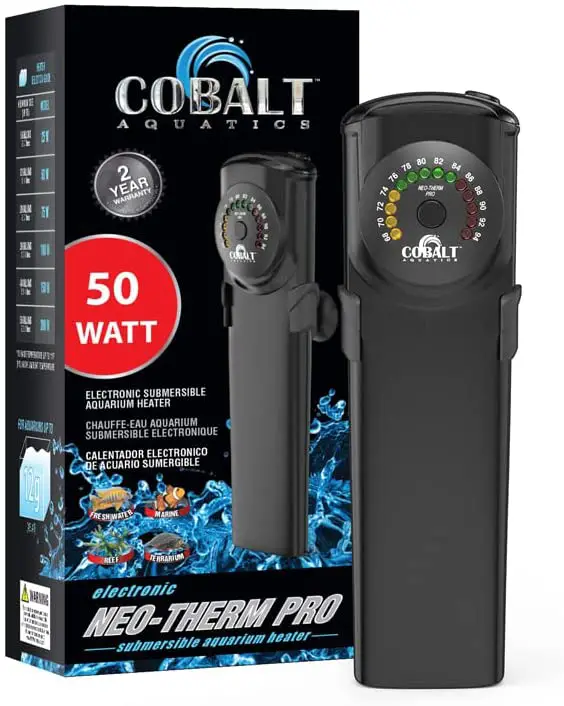
Cobalt has designed a unique product you would recognize anywhere. It’s a sleek, good-looking heater that won’t detract from your tank’s aesthetic.
It can heat your tank up to between 68 and 94 degrees whether you have a Nano-sized 6-gallon tank or a mid-sized 55-gallon tank.
As far as small aquarium heaters go, you may even notice these running in tanks as small as a gallon or less for shrimp displays in fish stores.
With their entire body being wrapped in a protective covering, even curious Neocaridina shrimp are safe to investigate this heater!
Of course, this small size and great coverage means this it is also the best heater for bettas, who will need much smaller, individual tanks.
The NEO-Therm Pro, best of all, carries a reputation for reliability and longevity.
What We Liked About This Product
- Attractive design
- A quality heater for small tanks (a rarity)
- Heavy duty cage
- Great warranty
- Takes up very little space
- Easy, visible temperature dial
Why It Might Not Work for You
- Expensive
- Only works on tanks up to 55-gallons
- Not the best customer service
Our Verdict: 4/5 stars. Buy it.
Cobalt truly is selling a great product. It’s innovative, comes with a great warranty, and is easy to operate.
You’ll want to avoid older and used options, as an earlier generation had a habit of spewing black goo.
In general, you’ll be hard pressed to find a higher quality, better designed heater than the NEO-Therm Pro.
>> Tap Here to Read More Reviews and See Today’s Price on Amazon.com <<

The Fluval E is popular for its genius design with a big, colorful display for its temperature.
Not only does the thermostat tell you what temperature it’s set to and what it is, but it does something many other heaters don’t: It tells you how it’s doing.
It flashes blue to let you know it’s cold, red when it’s too warm, and green when it’s at the desired temperature.
The colors and size of display mean it is visible from a glance any time you pass by. It also has a full-body cage with fine lines that protect most medium and larger fish from getting burned.
To top it off, good looking products is Fluval’s specialty.
What We Liked About This Product
- Big temperature display
- Full-body cage
- Attractive design
- Accurate thermometer
- 5-year warranty
- Made by Hagen
- Inexpensive
Why It Might Not Work for You
- Needs a lot of flow
- You might need two
Our verdict: 4/5 stars. Buy it.
This heater is a complicated recommendation.
I’ve had a couple die after a short life with no warning, and it turns out that’s not uncommon. However, they do tell you when they die.
They are also more likely to stop heating than to cook your fish overnight, which is…maybe better than the other way around?
Fluval/Hagen does honor its long warranty, but you pay to send the dead one home – which isn’t cheap with a 300w aquarium heater. With the price of a new heater going down over time, it’s almost cheaper to just buy the new one.
This heater also doesn’t heat as well as it should for as many watts as it provides, even when it’s bigger than the tank needs.
You need to make sure you have strong current somewhere in your tank and put the heater in it, and possibly double up, if you want it to heat properly.
All things considered, it’s still one of the best heaters on the market, if you’re willing to deal with its problems. There are still better ones, sure, but not many.
>> Tap Here to Read More Reviews and See Today’s Price on Amazon.com <<
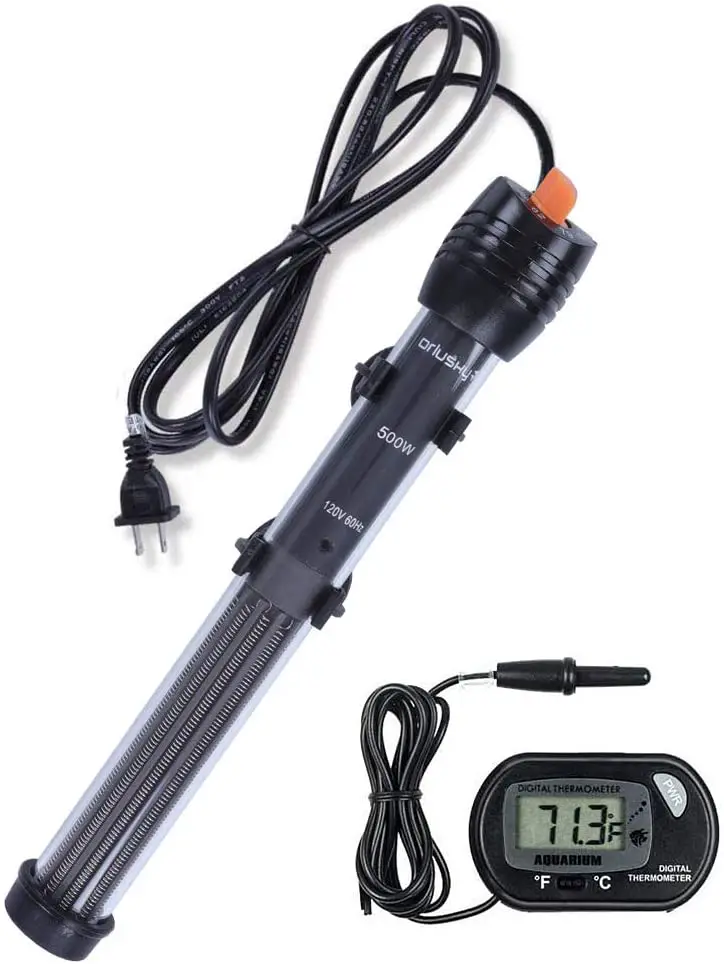
This in-line heater truly is the best of the bunch as far as in-line heaters go!
The heater offers up to 500 watts of raw power, heating up tanks between 68 and 89 degrees Fahrenheit. Choose the right model, though, to ensure you get the right wattage needed.
The 6 foot power cord makes it reasonably easy to situate near an outlet slightly further away.
It shows precise areas of how and where to adjust the temperature, and can easily be turned and adjusted in small intervals to tweak to just right.
The heater is – and I can’t believe I have to say this – touted as being explosion proof.
The 2 mm thick quartz glass is designed for use in freshwater or saltwater tanks.
Plus, it comes with a reliable, easy to adjust thermometer/thermostat that helps you maintain uniform temperature throughout the tank.
It also have an auto-shut off function to preserve your fish.
What We Liked About the Product
- Less clutter in the aquarium
- Inexpensive
- Adjustable to the degree
- Easy to use thermostat
- Works with acrylic tanks
Why It Might Not Work for You
- Short lifespan
- Harder to double up
- Slightly inaccurate thermometer
Our Verdict: 3.5/5 stars – a Good-Friendly Budget Option
This is, over-all, a budget-friendly option for any aquarium enthusiast. It’s not the top of the line, for sure, but it works and will keep your fish warm and comfortable for health.
It’s easy to install and use, has easy adjustable temperature control, and causes less clutter in the tank.
Overall, it’s a decent option for folks on a tighter budget who want to keep the aesthetic of their fish tank reasonably clear.
>> Tap Here to Read More Reviews and See Today’s Price on Amazon.com <<
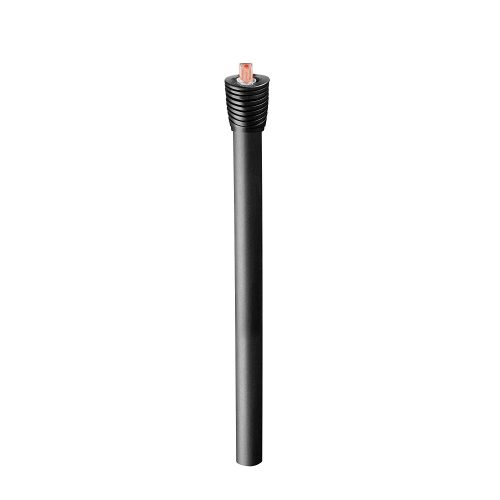
The Aqueon Pro sports a durable plastic cover and an adjustable knob at the top, making it easy to adjust your aquarium’s temperature without moving it. With a variety of sizes, it can fit most aquariums you keep.
Best of all, it’s got a limited lifetime warranty. Where most heaters carry a one-year warranty and are ahead of the pack with a 5-year warranty, Aqueon promises to replace your heater if it goes out, even if it’s been a decade.
They’ve been around long enough to back that promise. In many cases, you won’t even need to ship in the old one.
This is one of the best options on the market if you’re on a budget or feeling disillusioned about heaters after seeing a few too many poorly rated options.
Aqueon has a fantastic product here, but their quality control keeps them from falling into our top three.
What We Liked About the Product
- Adjustable
- Lifetime warranty
- Status light (red: heating, green: not heating)
- Low price
- Established brand name
- Fairly accurate
- Reliable; often lives for 3+ years
Why It Might Not Work for You
- Hit or miss quality
- Habit of splitting open
- Sometimes leaks red goo
- Difficult to read dial
Our Verdict: 3/5 stars. Buy it on a budget.
With as many expenses as there are in fish keeping, we all want to find ways to save money and do it right without going bankrupt. Aqueon, thankfully, offers us a solution for low cost heating that isn’t a safety concern, like many budget options are.
At this price range, you’ll find the quality on these Aqueon heaters is inconsistent. You might get one that lives 1 month or one that lives 10 years.
You might also have it simply fail and either cook your fish or stop heating, but it might also split open or leak a weird substance.
You’re also missing out on a lot of practical and beneficial features that more expensive heaters have.
On the other hand, it’s more often a successful purchase than not, and many people even purchase these in bulk over buying one expensive one.
It’s hard to beat its reliable functionality, adjustable thermostat, and lifetime warranty at this price. This is the go-to standard option for many fish keepers for good reason.
Do keep in mind you only get one replacement on the warranty
>> Tap Here to Read More Reviews and See Today’s Price on Amazon.com <<
Reviews of Popular aquarium Heaters We Don’t Recommend
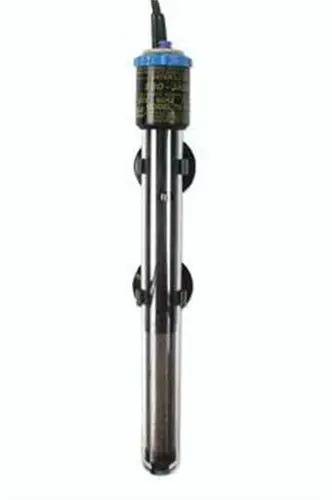
Eheim Jager is a long-standing quality name in the fish keeping hobby, and has to be on any list at this point.
One of the original heaters with an internal thermostat and temperature control dial, this heater can be had for a very low cost. It’s accurate and made of high-quality shatter-proof glass.
However, Eheim’s quality has been slipping lately, so this wasn’t able to make our top three. If they kept the quality up on this product, it would be a shoe-in.
What We Liked About the Product
- Low cost
- Classic design
- High quality glass
- Accurate thermostat
- Saltwater and freshwater
- When it works, it’s reliable
Why It Might Not Work for You
- Electrical concerns
- Poor customer service
- May fail within days
Our verdict: 2/5 stars. Do not buy.
I’d love to recommend this heater, but the Eheim’s slipping standards are a real concern. Even veteran fish keepers who once relied on this brand are concerned about the electronics and longevity of these products.
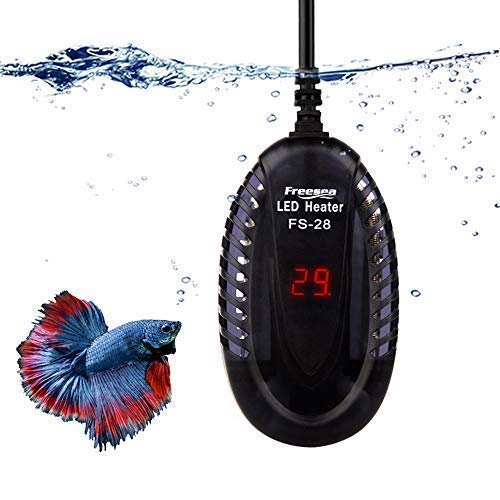
While this heater can heat larger aquariums, it can also be small enough to heat just 1 gallon. If you have a very small tank, this is the most popular choice.
It also has a large, easy to read LED display for the thermostat, which is controlled externally so you don’t need to remove the heater to change the temperature.
While this is a popular product and has great ideas behind it, it isn’t making it into our top three due to its lack of reliability.
What We Liked About the Product
- Small size
- Attractive shape
- Visible display
- Very low cost
- External thermostat control
Why It Might Not Work for You
- It might just not work
- Covering doesn’t cover back
- Inconsistent temperatures
- No internal memory
- Not a good idea for saltwater
Our verdict: 1/5 stars. Do not buy.
The design and concept of this heater is fabulous. The features are just great. In theory, it’s the perfect small heater.
The reality is, it’s cheap and you get what you pay for. It often stops working or doesn’t stop running, and the suction cups create enough space to expose and uncovered back to a curious fish.
It also doesn’t have an internal memory, so it will need to be reset every time you plug it in.
Overall, it’s more of a hazard than a help. Whether you need a smaller or bigger heater, there are better options.
How to Choose the Best Aquarium Heater
When Bigger Is Better For aquarium Heaters
When it comes to what size to get, it’s especially hard to choose if you have a size of tank that sits at the edge of a heater’s capability. I find this most common with tank sizes like 30 gallons, 50 gallons, 75 gallons, and so on.
If you can, err on the side of big.
If you have a 30-gallon tank and choose a heater that does 20-35 gallons, your heater will work harder to get your water up to the right temperature.
Author Note: If you have a cold house, absolutely choose the bigger heater. Your heater will have to work harder to raise a tank to 73 degrees in a 50-degree house than it will in a 70-degree house. The more you make it work, the more likely it is to encounter an issue.
In general, you don’t want to err more than a size or so up. If your heater is designed for 100 gallons and your tank is 10 gallons, it’s oversized.
Adjustability
One of the most important things you need in an aquarium heater is an easy to adjust temperature setting.
Author Note: Certain heaters will come with a set temperature and can’t be adjusted.
Access to the Controls
Another important thing to have in a heater is easy to access controls.
Temperature Readability
Water temperature is important enough that you need to be able to easily read the heater’s temperature.
Make sure the heater you buy is user-friendly and is easy to read.
Since the aquarium temperature gauge may be unreliable, it’s advised to also have an easy to read thermometer in the water.
Safety Features
Make sure to read the instructions because not even an aquarium heater can be submerged into water.
An important safety feature in a heater is an auto shut off, this prevents overheating the water.
The last feature to look for is a light indicator to help you know if the heater is on or off.
Raising The Temperature Enough Degrees For Your Fish
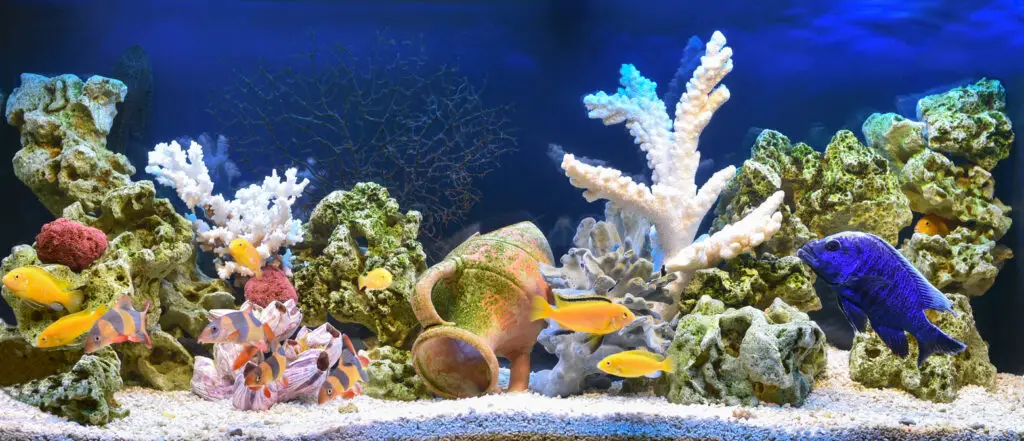
If your house really is 50 degrees and you’re hoping to bring it up by 20+ degrees, it’s better to get into the nitty gritty math here.
There is a formula to determine how many watts we need for an aquarium:

This equation shows how to determine how many watts you need to heat each gallon of water by how much in how much time.
It shows us that heating a 1-gallon tank in 1 hour by just 1 degree takes 3.1-watts.
This is how we determine the rule of 3-5 watts per gallon.
However, this also depends on your house’s temperature.
Here’s an example…
If you had a 50-degree house and a 5-gallon betta tank you wanted to raise to 70 degrees, and you wanted it done in about 5 hours, you would want a 62-watt heater.
That’s 3.1 x 5 gallons x 20 degrees divided by 5 hours.
On the other hand, most heaters are closer to 25-watts for a 5-gallon tank, which is more than plenty if you multiply 3-5 watts by 5 gallons and will do great if your house is closer to standard room temperature.
Many heaters, once you do the math, are expecting you to reach your desired temperature increase of about 3-5 degrees within 3 hours.
To simplify shopping, you can divide the wattage of a heater by the gallons in your tank to determine how much it will heat your fish tank in about 3 hours.
It’s the simplified version of solving the equation above when you’re reaching your temperature in 3.1 hours, and you’ll often find it’s the inverse of 3 watts per gallon.
If there’s a larger discrepancy between your desired temperature and your house’s temperature, size up.

Top Tip: If you have a larger aquarium, you can do two medium heaters rather than one large one. This helps ensure that you are also protected in case one fails and protects them from wearing out due to running constantly.
What Heater Material To Choose
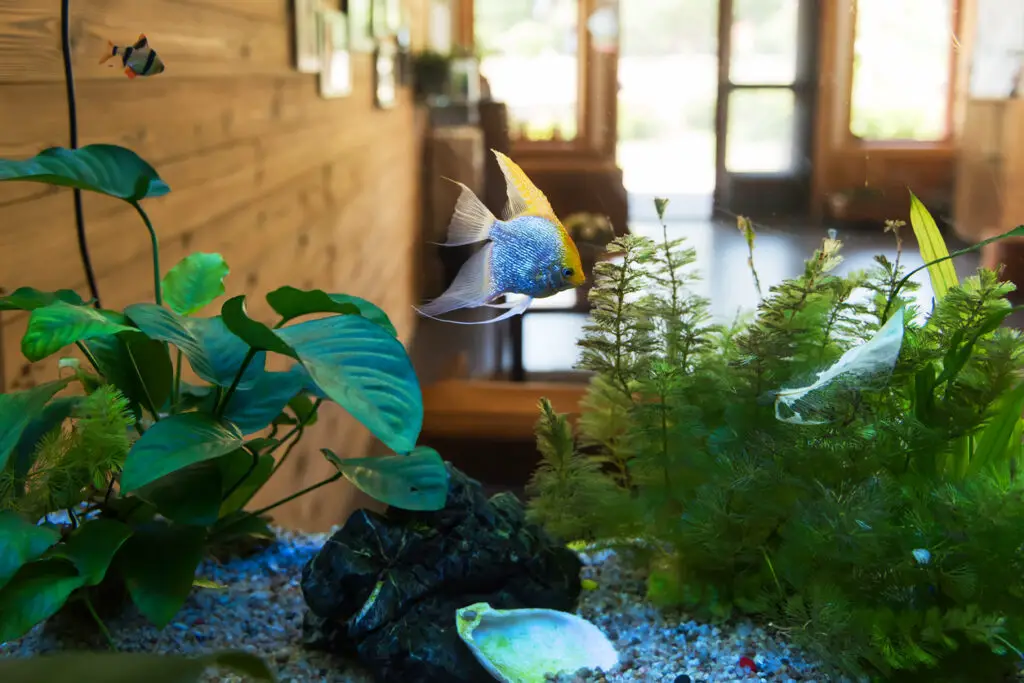
Glass
Heaters made of glass are less expensive, easy to find, and usually include a thermostat inside the heater. Even shatterproof glass is more fragile and can break easily.
Glass heaters especially should also be allowed to cool before you begin a water change and acclimate before powering them on.
Titanium
Titanium is a hardy, tough material that can reach very high heats and are more difficult to damage.
Titanium heaters usually have a separate thermostat to sense the fish tank’s temperature and adjust it. While this means you may need to buy a separate thermostat, it also means you won’t need to replace the entire heater if it fails.
Plastic
Some heater manufacturers are starting to make their heaters completely covered in plastic. They are attractive and less likely to burn your fish.
Cords & Electronics
Any heater you choose should be safe to use. If the cord is so short that you cannot create a drip loop to prevent water from running down the cord into a power socket, it is not safe to use.
Ensure any heater you purchase is UL listed. It is, after all, going directly into water where you keep fish, plants, and even your hands.
Additional Purchases
There’s only a couple more things you may want to consider with your heater.
A Thermometer
You can get a thermometer for cheap, but you should also consider an instant read thermometer to make checking your tanks easy. Whether your thermostat is external or internal, you’ll want to catch any inconsistencies sooner than later.
Since you can get a waterproof instant read thermometer that reads in under 3 seconds for under $20, it’s worth it. It’ll save you more than it costs.
An External Thermostat
You can get a thermostat even if your heater comes with one. Just ensure the thermometer is waterproof. If you have a saltwater tank, it should be corrosion proof as well.
